From the winter garden I started in August of last year there remains: chard, kale, radish, okra and marigold. The poor eggplant seemed great and then died suddenly. Maybe it was cold stress, drought stress, or light stress.
I don't remember when I started organizing my seed into plant families, I guess it was just starting to grow out of control and I couldn't find anything. Making a label on the outside of the bag was a great way to find exactly what type of plant I was looking for without digging through every single bag. The bags I get free during Clinique bonus week and since I'm not really a make-up-a-holic, I use the bags to sort and store my seeds. I put all these little bags into a camo backpack that I can sometimes take with me to the Seed Library of Los Angeles (SLOLA) meetings.
This past month we had a talk from David King the founder of SLOLA and he spoke about planning for our summer gardens. He specifically went over the considerations for seed-saving. He is a teacher through UCLA Extension and the garden master at the Venice High School Learning Garden.
David encouraged us to set a goal and be clear at the start of a project (or season). That way you know when you are approaching, meeting and exceeding your goal. He said that it's easy to give away seeds, but it's hard to be persistent. In other words, it's not always the first time around that you will be able to get a yield of seeds back from what you plant.
For us in the valley, a concern is that pollen is killed at temperatures above 85 degrees F so that you will have to get up early if you want to hand-pollinate your plants.
Beans - let them become very dry on the plant. Put them in a plastic bag and freeze for 3 days. You can get seeds from the grocery store bulk bins. They will germinate.
Peppers - can cross pollinate. To prevent unintended hybridization, put cloth bags around the flowers. They are "perfect flowers" because they can self-fertilize.
Tomatoes - can cross pollinate. Pollination is typically by wind. Cherry tomatoes cross pollinate by insects. They also can self-fertilize.
Squash - susceptible to powdery mildew. If you plant now, you can harvest in July. Then plant in July for a winter harvest. You need male and female flowers, so plant as many as you can.
Tomatillo - similar to tomato and pepper. It's not as common so there's low risk of cross-pollination. Unlikely that your neighbors will be growing it.
Amaranthaceae - includes spinach, sugar beet, chard, quinoa. These are wind pollinated. The pollen can travel up to 25 miles.
Corn - typically hand pollinated. Combine 3-5 tassles in a paper bag. Shake it. Dump the pollen on the silk. This yielded him 35 kernels per ear. Corn pollen can travel 250 miles under ideal conditions.
Here's what seeds I've planted. So far the lettuces have popped right up. A variety of the flowers have also sprouted but I mixed them up so I doubt I'll know which is which until they get larger. You can follow the progress of these plants in my facebook album.
https://www.facebook.com/media/set/?set=a.10156253751764127.1073741896.660124126&type=1&l=05a6d71e4d
Also, I only planned to plant the spinach and eggplant, but never did it (oops) will try to get those on (in) soil today or tomorrow. Happy Cesar Chavez day, California!
I feel as though the plants have entrusted me to be a steward of their progress. I am constantly humbled by some plants' ability to survive under my lack of care. And I am surprised when those plants reward me with their fruits. I made the most amazing salad of radish and chard for the SLOLA meeting! 🌱


No comments:
Post a Comment